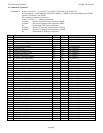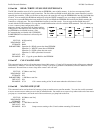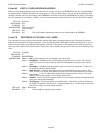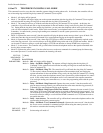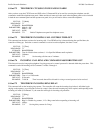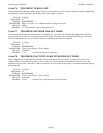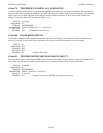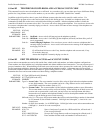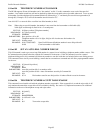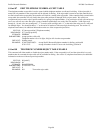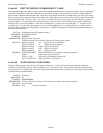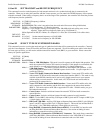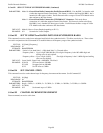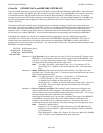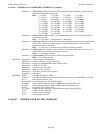
Pacific Research Solutions RI-300e User Manual
Page 94
S-Cmd 82 TELEPHONE ON/OFF-HOOK AND ACCESS/ACCOUNT CODE
This command is used to move the telephone on or off-hook. As you make a call, you can select one of up to 8 different dialing
prefixes for a long distance service access number, or you can select a special PBX “Outside Line” number.
In addition to the dial prefixes, there is space for 8 different account codes that can be stored for credit card use. Use
S-Command 83 to program access codes and account codes for this dialing process. Included in a telephone macro, this
command will check and use the access code table before dialing any number. After the telephone number is dialed, the
controller will check for an account code to dial. Use access code zero to hang up the telephone. You can also use access code
9 to answer a telephone that is currently ringing over the air. Access code 9 will return an error message if the telephone was
not ringing over the air.
SYNTAX: 82 [Code]
READ BACK N/A
STORAGE: RAM
PARAMETERS: Code 0 =
On-Hook:
Access code 0 will hang-up (put the telephone on-hook).
Code 1-8 =
Off-Hook:
Access code 1-8 will bring up the telephone (off-hook), and then dial a prefix if
one is programmed.
Code 9 =
Answer Ringing Telephone:
You can also use access code 9 to answer a telephone that is
currently ringing over the air. Access code 9 will return an error message if the telephone were
not ringing over the air.
DEFAULT: N/A
EXAMPLE: 82 1 Go off-hook and dial access code if any, then the telephone and account code, if any.
82 0 Go on-hook, (hang up)
82 9 Answer the telephone if currently ringing over the air.
S-Cmd 83 EDIT TELEPHONE ACCESS and ACCOUNT CODES
Access and account numbers are used to dial outside lines, submit credit card numbers, and other telephone configurations.
These numbers are dialed with the user’s telephone number and without additional user intervention. You can program up to 8
groups of numbers to dial. When building an off-hook access and account code to operate with a credit card, you may have to
test and experiment with delays between the access number and the telephone number. Adjustments may also be required
between the telephone number and account number to get the dialing process to work correctly. The off-hook S-Command 82
determines the access and account number used when dialing a telephone number.
SYNTAX: 83 [Type] [Off-hook code] [Number]
READ BACK 83 * [Type] [Off-hook code]
STORAGE: EEPROM
PARAMETERS: Type 0 =
Access Codes:
The access number is used to dial a string of digits before the telephone number
or auto dialer number. The access number can be for a long distance service access number or
special PBX outside line number. (Such as “9”)
Type 1 =
Account Codes:
The account number is dialed after the telephone number or auto dial number.
The account number can be used for credit card dialing. When building an off-hook access and
account code to operate with a credit card, you may have to test and experiment with delays
between the access number and telephone number as well as the telephone number and account
number to get the dialing process to work correctly.
Off-hook code 1-8 = The access and account number that will be used when dialing a number is determined
by S-Command 82, the off-hook command. Valid digits are 0 through 9, *, # and A for a two
second pause.
Number = 0 digits clears number, 1 to 16 DTMF digits. Valid digits in the access and account numbers are
0 through 9, *, # and A for a two second pause.
DEFAULT: Nothing stored.
EXAMPLE: 83 0 1 9A Store a 9 and pause 2 seconds for a PBX outside line, off-hook code 1.
83 0 2 Clear access position 02.
83 0 3 18005555555AA Set up to dial a long distance credit card company for off-hook code 3.
83 1 3 AA123456789 Pause and then dial the credit card number for off-hook code 3.



